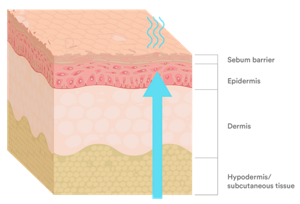How to Get Rid of Dry Skin: Top Tips from
Dermatologists

When our skin is hydrated, it’s soft, supple and smooth. But dry skin, which can happen from your face to your feet, can cause itchiness, flakiness, and irritation. Although dry skin can be caused by a variety of factors, there are ways to manage the condition and help you get rid of dry skin for good.
Dry Skin Symptoms and Signs

Early symptoms of dryness include skin feeling tight or rough. It’s important to address the condition before the skin becomes severely dry or cracked. “Dry skin is more than a nuisance—the condition can cause irritation and discomfort when not treated properly. For example, one sign of dry skin is cracking—also known as skin fissures— which occurs when the skin loses its ability to hold moisture, thus compromising the skin’s moisture barrier,” says Lisa Adams, Skincare expert at Curél Brand.
“Dry skin is more than a nuisance—the condition can cause irritation and discomfort when not treated properly.”
Common signs of dry skin
Now that you know some of the signs and symptoms of dry skin to look out for, it’s important to also recognize what factors cause dry skin.
Skin is gray or dull in appearance:
“Dead-cell build-up from dry skin can make your skin look gray and dull,” explains Dr. Debra Jaliman, a board-certified NYC dermatologist and assistant professor of dermatology at Icahn School of Medicine at Mount Sinai.Skin feels tight after washing:
If you get out of the shower and your skin feels tight, that’s another indication that you’re suffering from dry skin.Skin looks red or blotchy:
“This often happens when the skin’s barrier loses enough moisture to become disrupted. Once disrupted, external irritants easily pass through the skin’s permeable barrier, causing redness,” says Adams from Curél Brand.Skin feels itchy and uncomfortable:
"Once the skin barrier has flaked off and the nerve endings that are normally protected by the skin are exposed, itching occurs,” says Adams.
What Causes Dry Skin?
Dry skin is common because many bad habits, medical conditions, and environmental factors can cause it. Your skin is affected by everything you come into contact with throughout the day. It's key to know how to keep your skin healthy because it serves as a physical barrier between your body and the external world.
Many factors can cause dry skin. Poor habits, such as your diet or skincare routine, can cause dryness by not giving your skin the nutrients it needs. Environmental and external factors like sun exposure, irritants, and allergens can cause adverse reactions in your skin that lead to dryness. Individual factors like genetics and hormones can make your skin more prone to dryness. Learn more about the causes of dry skin by reading our guide to what causes dry skin.
Next, we turn to our dermatologists and skincare experts for treatments and tips on how to get rid of dry skin.

7 Dermatologist Tips to Get Rid of Dry Skin
Dry skin is never fun, as it often comes with skin discomforts such as tightness, itchiness, and flaking. But whatever the cause of your dry skin, it is possible to get rid of dry skin with the help of the right products. Employing smart tricks into your skincare routine and making positive lifestyle choices can help mitigate dry skin and its effects.
1. Use moisturizers with hydrating ingredients
There are two great ingredients to look out for on the label: ceramides and glycerin. “Ceramides are naturally present in healthy skin and are the vital building blocks to keeping skin’s moisture barrier functioning properly. When ceramides are lost, your skin becomes dry and damaged. Glycerin, a humectant, keeps things moist for both immediate and long-lasting hydration,” says Adams.

2. Exfoliate—but gently
Exfoliating the skin—either with a tool like a dry brush or with a scrub—helps remove excess dead skin cells along with flakes and dry patches. "Gently exfoliating removes the oldest dead skin cells on the outermost surface of the skin, which in turn improves the skin’s texture and radiance,” says Adams. However, the keyword here is gentle. “Rigorous actions and tools are actually abrasive and can cause micro-tears in the skin,” says Adams.
Skip the loofah, and opt for a washcloth instead; or a cleanser with foaming action, which removes debris from the surface without harsh abrasions.
3. Stay Hydrated
Drinking water is just as crucial as using moisturizer, as hydration starts from the inside out. Adams recommends drinking at least eight glasses of water per day and drinking two of those glasses as soon as you wake up. “Your skin loses moisture to the environment; and the drier the environment is, the more water you’ll lose overnight and therefore the more you’ll need to drink the next day to replenish the moisture loss that occurred through your skin,” explains Adams.
4. Avoid long and hot baths or showers
While a hot shower or bath may feel good, it won’t do your skin any favors. “Hot temperatures can strip the skin of natural moisturizers,” notes Adams. Stick to short, lukewarm showers—think under ten minutes—and you’ll notice that your scorching hot water was probably causing some of those flakes in the first place. Likewise, your shower temperature should range between 96 and 99 degrees Fahrenheit, with the general rule that the water should be close to your own body temperature. So if you get out of the shower and your skin’s all red and flushed, turn that dial down!

5. Apply lotion immediately after showering
The best time to lock hydration into the skin is as soon as you finish showering. For example, a wet skin moisturizer can be applied to the skin right after showering, or you can stash your moisturizer in the shower so you don’t forget to apply it. That way, your moisturizer works as hard as possible on damp skin. “A good moisturizer is designed to retain and lock moisture in the skin and leave the skin feeling soft and smooth,” says Adams.
6. Eat foods high in carotene and omega-6 fatty acids
Another important way to build the skin’s barrier is to start from the inside out and by eating vitamin-rich and nutrient-dense whole foods. You can literally feed your skin from the inside out. For example, ingesting omega-6 fats, such as those found in the avocado, can make skin smoother and more supple. Foods rich in beta-carotene, such as carrots or sweet potatoes, help prevent damaging free radicals from interacting with the skin.
7. Use natural emollients
If you have dry skin, emollients are a perfect way to replenish your skin’s moisture levels. According to Wikipedia, “Emollients are used for protecting, moisturizing, and lubricating the skin. These functions are normally performed by sebum produced by healthy skin.” Some effective emollients Adams recommends are:
Treating Dry Skin
Maintaining a good skincare routine is essential Adam explains that “the best way to treat dry skin is through a combination of ingredients.” Using a combination of specific products in your skin routine is crucial to treating dry skin. For example, Dr. Jaliman always recommends starting out with a mild cleanser. She advises, “Look for one with glycerin—which is a water-holding humectant—on the ingredient label, as it will prevent that tightness in the skin.” She also warns, “Make sure to stay away from harsh soaps as they’ll actually just dry out your skin more.”
Once your skin has been cleansed, the key is to use a lotion for dry skin that keeps skin hydrated and creates a protective barrier that locks moisture into your skin, while also preventing environmental factors from getting inside. Adams recommends looking for a wet skin moisturizer with ceramides, a natural lipid that helps retain skin’s moisture levels. Adams also suggests, “For sensitive skin around the eyes, try something lightweight that will rub in easily as to not irritate the skin. Look for a fragrance free lotion that contains ingredients like glycerin.”
Key Takeaways
Getting rid of dry skin isn’t a quick fix and involves a series of lifestyle and product tweaks. If you’re looking to get rid of dry skin, consider adding these tips to your skincare routine:






